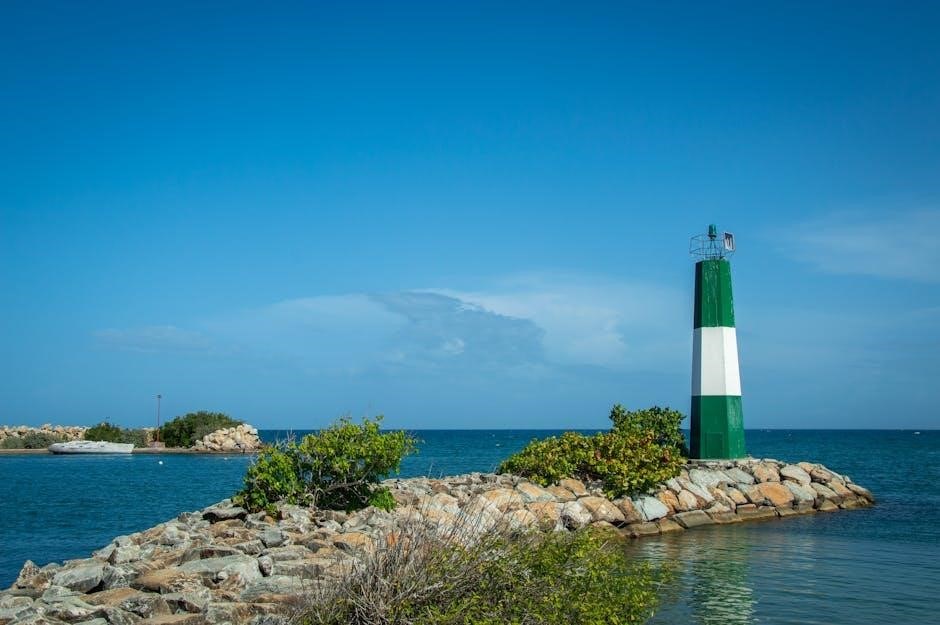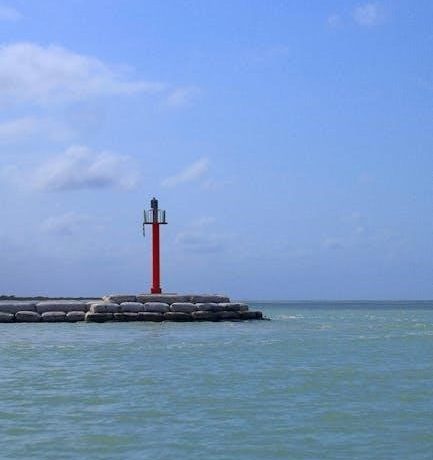Outdoor lighting size guide helps enhance ambiance, functionality, and safety in outdoor spaces by selecting appropriate light fixtures that complement the area’s design and dimensions effectively․
1․1 Why Lighting Size Matters for Outdoor Spaces
Lighting size is crucial for outdoor spaces as it impacts both functionality and aesthetics․ Properly sized fixtures ensure adequate illumination, safety, and visual harmony, complementing the space’s scale and design while addressing energy efficiency and maintenance needs․
1․2 Key Factors to Consider When Choosing Outdoor Lighting
When selecting outdoor lighting, consider the space’s size, fixture type, and purpose, such as path, wall, or hanging lights, ensuring they align with the area’s architecture and desired ambiance while meeting safety and energy efficiency standards․

Understanding Different Types of Outdoor Light Fixtures
Outdoor light fixtures vary in design and functionality, including wall-mounted, post-mounted, and hanging options, each offering unique benefits for enhancing your space’s ambiance and illumination needs․
2․1 Wall-Mounted Outdoor Lights
Wall-mounted outdoor lights are versatile and ideal for illuminating entryways, porches, or garages․ They come in various designs, from modern to traditional, and can be adjusted to suit different wall types․ Proper sizing ensures balanced lighting without overwhelming the space․ Consider the fixture’s height and width relative to the wall and surrounding architecture for a harmonious look․ Energy-efficient options are also available to enhance functionality while reducing power consumption․
2․2 Post-Mounted Outdoor Lights
Post-mounted outdoor lights are ideal for driveways, gardens, and pathways, providing both illumination and decorative appeal․ Available in various styles, they can be tailored to suit different landscapes․ Durable materials like stainless steel or brass ensure longevity․ Proper sizing ensures the light covers the intended area without being overpowering․ Consider the height and spacing for even coverage․ Energy-efficient options, such as solar-powered post lights, offer eco-friendly solutions while maintaining functionality and aesthetics․
2․3 Hanging Outdoor Lights
Hanging outdoor lights add a touch of elegance to porches, patios, and gazebos․ They come in styles like lanterns or pendant lights, offering versatile designs․ Size should match the space—smaller for intimate areas, larger for grandeur․ Consider weather resistance and energy efficiency, such as LED options․ Proper installation ensures stability and safety․ Hanging lights can create ambiance while providing functional illumination, enhancing outdoor living spaces with their unique charm and versatility in design․
The Role of Space and Area Size in Outdoor Lighting
Space and area size are crucial for proper illumination, ensuring aesthetic appeal, safety, and functionality in outdoor settings by guiding fixture selection and placement effectively always․
3․1 Measuring Your Outdoor Space
Accurately measuring your outdoor space is essential for determining the appropriate lighting layout․ Start by calculating the length and width of your patio, garden, or walkway․ Use a tape measure or laser tool for precise dimensions․ Consider irregular shapes by breaking them into smaller sections․ Record all measurements to ensure your lighting plan fits perfectly․ This step ensures optimal coverage and visual balance in your design․
3․2 Calculating the Number of Lights Needed
To determine the number of lights needed, consider the size of your space, desired brightness, and light fixture wattage․ Divide the area by the coverage per fixture, typically 50-100 square feet per light․ Adjust based on walkway width, with narrower paths requiring closer spacing․ For ambient lighting, fewer fixtures may suffice, while task lighting needs more precise placement․ This calculation ensures even illumination without overlighting․
Path and Walkway Lighting
Path and walkway lighting enhances safety, illuminates walkways, and adds visual appeal, creating a welcoming ambiance while guiding nighttime movement effectively․
4․1 Choosing the Right Size for Path Lights
When selecting path lights, consider the walkway’s width and desired illumination level․ Lights ranging from 18 to 24 inches in height are ideal for most pathways, ensuring even coverage․ Taller lights may overwhelm smaller spaces, while shorter ones might not provide sufficient visibility․ Balance functionality with aesthetics by choosing sizes proportional to surrounding features, ensuring a harmonious and safe outdoor environment․
4․2 Spacing Guidelines for Walkway Lights
Proper spacing of walkway lights ensures even illumination and safety․ Place lights 8 to 12 feet apart for standard pathways, adjusting based on fixture height and desired brightness․ Taller lights can be spaced further, while shorter ones may require closer placement․ Avoid overlighting by maintaining consistent spacing, creating a balanced and visually appealing outdoor ambiance that enhances both functionality and aesthetics without overwhelming the space․

Landscape Lighting Considerations
Landscape lighting enhances outdoor beauty and functionality, ensuring safety while highlighting key features like trees, gardens, or water elements․ Choose fixtures that blend seamlessly with your environment, balancing aesthetics and energy efficiency to create a welcoming and well-lit space that complements your home’s exterior design and natural surroundings effectively․
5․1 Selecting Lights for Gardens and Landscapes
Selecting lights for gardens and landscapes involves choosing fixtures that enhance beauty and functionality․ Consider spotlights for highlighting focal points, pathway lights for illumination, and ambient options for soft glow․ Ensure fixtures are weather-resistant and energy-efficient, with designs that complement your garden’s style․ Choose appropriate sizes to avoid overwhelming or underlighting the space, balancing aesthetics with practicality to create a harmonious and inviting outdoor environment that reflects your unique landscape design and needs effectively․
5․2 Balancing Aesthetics with Functionality
Balancing aesthetics with functionality in outdoor lighting requires careful selection of fixtures that enhance both beauty and purpose․ Choose designs that complement your landscape and architecture while ensuring sufficient illumination for safety and usability․ Consider energy-efficient options like LED lights to reduce environmental impact without sacrificing style․ Proper placement and sizing of lights ensure a cohesive look that blends seamlessly into your outdoor space, creating an inviting and functional environment․
How to Choose the Right Size for Your Outdoor Lights
Assess your space and fixture proportions to ensure harmony; Consider the area’s purpose and lighting needs, then consult a sizing chart for the perfect fit outdoors․
6․1 Assessing the Scale of Your Outdoor Space
Start by measuring your outdoor area’s length, width, and any obstacles․ Consider the space’s purpose—whether for entertaining, relaxation, or pathways․ Larger areas may require bigger fixtures, while smaller spaces benefit from more subtle lighting․ Assessing scale ensures your lighting complements the environment without overwhelming it, creating a balanced and functional setup․
6․2 Matching Light Fixtures to Your Home’s Architecture
Outdoor lighting should harmonize with your home’s architectural style․ Modern homes often benefit from sleek, minimalist designs, while traditional or rustic styles pair well with classic lanterns․ Consider the shape, material, and finish of fixtures to ensure they complement your home’s exterior․ Balancing aesthetics with functionality ensures your outdoor lighting enhances both curb appeal and usability, creating a cohesive and inviting outdoor space․
Safety and Regulations
Ensure outdoor lighting complies with local safety codes and regulations․ Proper installation and placement prevent hazards, while energy-efficient options reduce environmental impact and operational costs effectively․
7․1 Compliance with Local Lighting Regulations
Compliance with local lighting regulations is essential to ensure safety and avoid legal issues․ Always consult local authorities or licensed electricians to confirm that your outdoor lighting setup adheres to specific laws and standards․ This includes proper installation, brightness levels, and placement to minimize light pollution․ Adhering to these guidelines not only prevents fines but also promotes environmental sustainability and neighborhood harmony․ Proper documentation and permits are often required․
7․2 Ensuring Safe Installation Practices
Safe installation practices are crucial for outdoor lighting to prevent hazards and ensure longevity․ Always turn off the power supply before starting work and use weather-resistant materials suitable for outdoor conditions․ Follow proper wiring techniques and secure fixtures firmly to withstand weather conditions․ Hiring a licensed electrician is recommended for complex setups․ Test all lights after installation and maintain regular inspections to ensure everything functions safely and efficiently․

Aesthetic Considerations
Aesthetic considerations ensure outdoor lighting enhances visual appeal while blending seamlessly with the surroundings, balancing design and functionality to create a harmonious and inviting outdoor space․
8․1 Designing a Cohesive Outdoor Lighting Plan
Designing a cohesive outdoor lighting plan involves balancing light fixtures, sizes, and placements to create harmony․ Start by assessing the space’s flow, then select fixtures that complement the architecture․ Mix sizes to avoid clutter, ensuring larger lights highlight focal points while smaller ones provide subtle accents․ Layer lighting for depth, using ambient, task, and accent lights․ Consider warm tones for a welcoming feel and energy-efficient options for sustainability․ A well-designed plan enhances curb appeal and functionality seamlessly․
8․2 Mixing Different Light Sizes for Visual Interest
Mixing different light sizes adds visual interest to outdoor spaces․ Larger fixtures can highlight focal points, while smaller ones provide subtle accents․ Varying sizes creates depth and prevents monotony․ Balance by pairing bold statement pieces with understated designs․ Ensure proportions align with the space to avoid clutter․ This layered approach enhances the overall aesthetic, making the area more inviting and visually dynamic without overwhelming the senses․

Maintenance and Energy Efficiency
Regular maintenance ensures outdoor lighting longevity․ Use energy-efficient options like LED bulbs to reduce power consumption and lower costs while maintaining bright, reliable illumination for years․
9․1 Tips for Maintaining Outdoor Lighting
Regularly clean fixtures to prevent dirt buildup, which reduces light output․ Inspect wiring for damage and replace worn-out bulbs promptly․ Seasonally check for pest nests and corrosion․ Use weather-resistant materials to withstand harsh conditions․ Trim nearby foliage to ensure optimal light distribution․ Schedule annual professional inspections for complex systems․ Proper maintenance ensures safety, efficiency, and longevity of your outdoor lighting setup while maintaining its aesthetic appeal and functionality․
9․2 Energy-Saving Options for Outdoor Lighting
LED lights and solar-powered fixtures are excellent choices for energy efficiency․ Motion sensors and timers reduce unnecessary usage․ Smart lighting systems optimize energy consumption while maintaining functionality․ Energy-saving options lower electricity costs, extend bulb lifespan, and reduce environmental impact․ Choose fixtures with high energy ratings to ensure long-term sustainability and performance for your outdoor space․
Selecting the right outdoor lighting size enhances both functionality and aesthetics․ Consider space, fixture types, and energy efficiency to create a harmonious and well-lit outdoor environment․
10․1 Final Tips for Selecting the Perfect Outdoor Lighting Size
When selecting outdoor lighting, prioritize space measurement and fixture proportions․ Choose sizes that align with your home’s architecture and the area’s purpose․ Balance functionality with aesthetics by ensuring lights are neither too bulky nor too subtle․ Consider energy-efficient options and test placements before final installation to achieve the perfect blend of form and function for your outdoor space․
